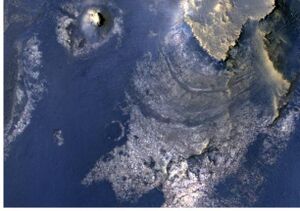Astronomy:McLaughlin (Martian crater)
McLaughlin Crater viewed from orbit - small 0.550 km (0.342 mi) portion of 90.92 km (56.50 mi) diameter crater floor is shown - (MRO, HiRISE) (January, 2013). | |
| Planet | Mars |
|---|---|
| Region | Oxia Palus quadrangle |
| Coordinates | [ ⚑ ] : 21°54′N 337°38′E / 21.9°N 337.63°E[1] |
| Diameter | 90.92 km (56.50 mi)[1] |
| Depth | 2.2 km (1.4 mi)[2] |
McLaughlin Crater is an old crater in the Oxia Palus quadrangle of Mars, located at [ ⚑ ] 21°54′N 337°38′E / 21.9°N 337.63°E. It is 90.92 km (56.50 mi)[1] in diameter and 2.2 km (1.4 mi)[2] deep. The crater was named after Dean B. McLaughlin, an American astronomer (1901-1965).[1][3] The Mars Reconnaissance Orbiter has found evidence that the water came from beneath the surface between 3.7 billion and 4 billion years ago and remained long enough to make carbonate-related clay minerals found in layers.[2][4] McLaughlin Crater, one of the deepest craters on Mars, contains Mg-Fe clays and carbonates that probably formed in a groundwater-fed alkaline lake. This type of lake could have had a massive biosphere of microscopic organisms.[5]
See also
- 2024 McLaughlin, minor planet
- Climate of Mars
- Impact crater
- List of craters on Mars
- McLaughlin (lunar crater)
- Water on Mars
References
- ↑ 1.0 1.1 1.2 1.3 1.4 1.5 IAU Staff (17 November 2010). "McLaughlin - Crater, Mars, 3782". IAU. http://planetarynames.wr.usgs.gov/Feature/3782.
- ↑ 2.0 2.1 2.2 2.3 Choi, Charles Q. (20 January 2013). "Giant Mars Crater Shows Evidence of Ancient Lake". Space.com. http://www.space.com/19348-giant-mars-crater-water-lake.html.
- ↑ "Home". http://planetarynames.wr.usgs.gov/.
- ↑ "Martian Crater May Once Have Held Groundwater-Fed Lake". http://www.jpl.nasa.gov/news/news.php?release=2013-028.
- ↑ Michalski, J., J. Cuadros, P. Niles, J. Parnell, A. Rogers, S. Wright. 2013. Groundwater activity on Mars and implications for a deep biosphere. Nature geoscience:6, 133–138.
 |



